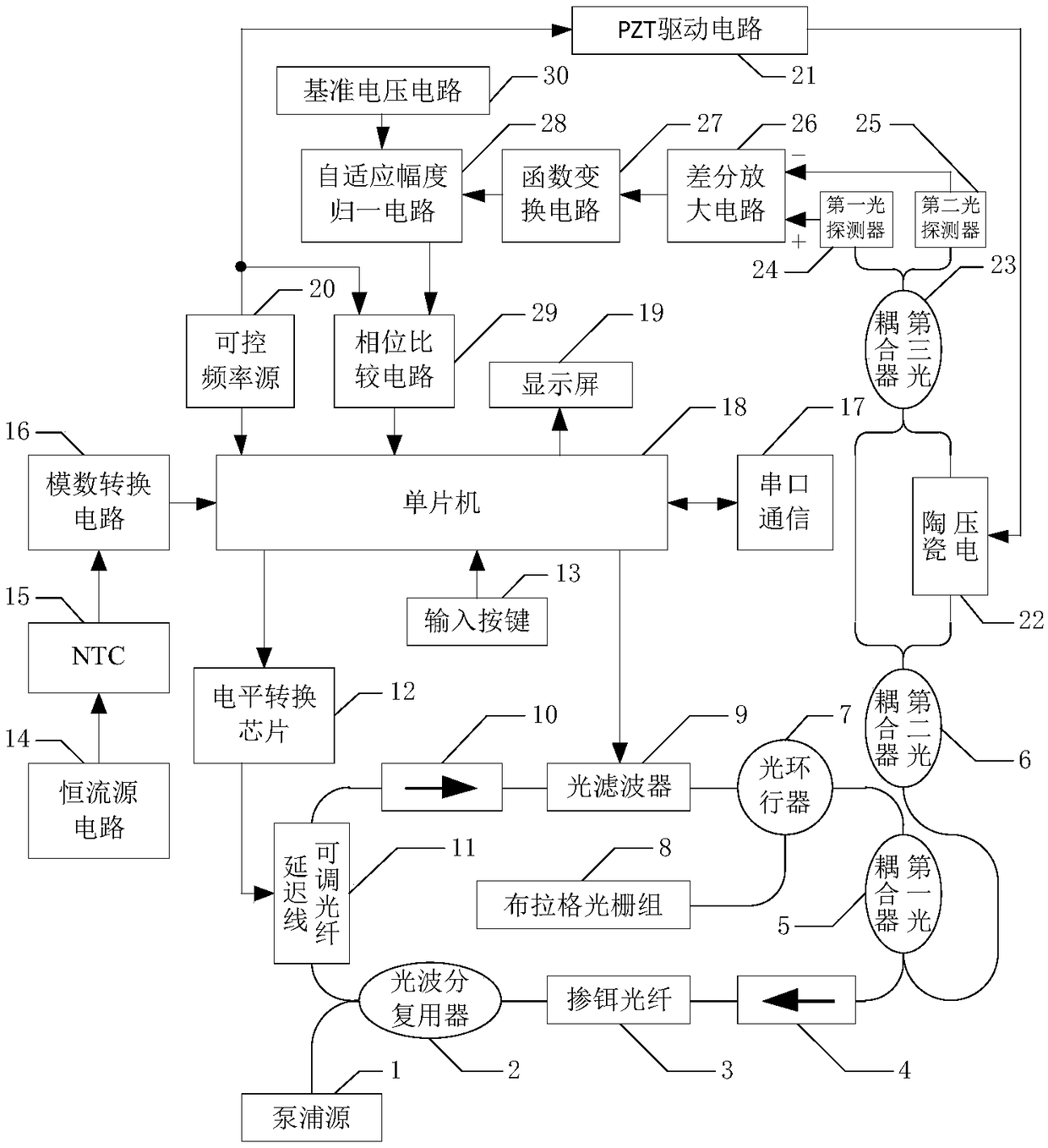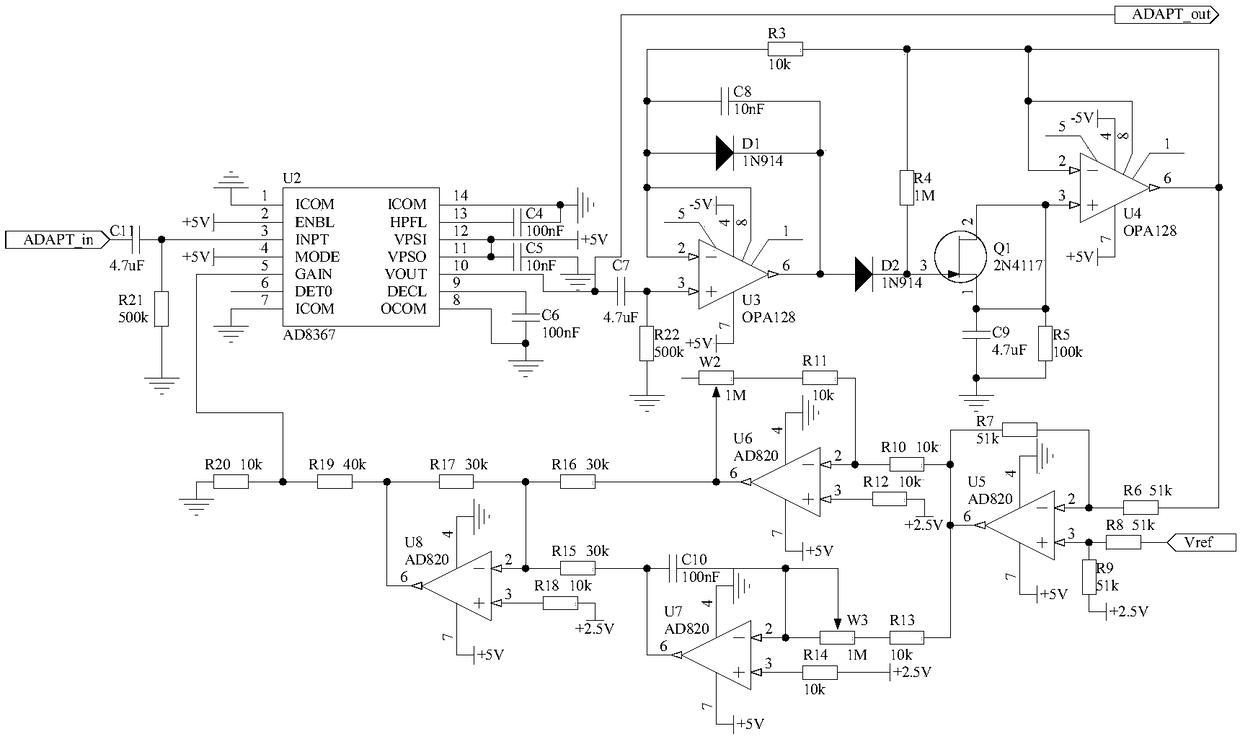Micro-stress sensor for bridge monitoring
A micro-stress and sensor technology, applied in the direction of measuring force, measuring the change of optical properties of the material when it is stressed, and instruments, etc., can solve problems such as difficult to filter out, variable frequency, unfavorable optical fiber sensors, etc. , to achieve the effects of wide application, small phase detection error, and improved sensing accuracy
- Summary
- Abstract
- Description
- Claims
- Application Information
AI Technical Summary
Problems solved by technology
Method used
Image
Examples
Embodiment 1
[0028] Embodiment 1 Overall structure of the present invention
[0029] like figure 1 As shown, the overall structure of the present invention has, the pump source 1 (980nm laser, maximum output power is 1W) is connected with the 980nm end of the optical wavelength division multiplexer 2 (980 / 1550nm wavelength division multiplexer), and the optical wavelength division multiplexer The 1550nm end of the device 2 is connected to one end of the delay line adjustable optical fiber 11 (VDL-40-15-S9-1-FA type electric optical fiber delay line of Sichuan Yuxingguang Technology Co., Ltd.), and the other end of the delay line adjustable optical fiber 11 One end is connected with the input end of the first optical isolator 10 (1550nm polarization-independent optical isolator), the control end of the delay line adjustable optical fiber 11 is connected with the output port of the level conversion chip 12 (MAX232), and the output port of the level conversion chip 12 The input end is conne...
Embodiment 2
[0031] Embodiment 2 function conversion circuit
[0032]The structure of the function conversion circuit 27 is that one end of the capacitor C3 is connected to the pin 12 of the trigonometric function converter U1 and one end of the resistor R2, and the other end of the capacitor C3 is used as the input end of the function conversion circuit 26, which is denoted as the port ACOS_in , is connected with the output end of the differential amplifier circuit 17; the other end of the resistor R2 is grounded; the pins 2, 3, 4, 5, 8, 11, 13 of the trigonometric function converter U1 are grounded, and the pins 9, 10 are connected to the capacitor C2 One end is connected to -12V power supply, the other end of capacitor C2 is grounded; pin 6 of trigonometric function converter U1 is connected to pin 7, pin 16 is connected to +12V power supply and one end of capacitor C1, and the other end of capacitor C1 is grounded; The pin 1 of the trigonometric function converter U1 is connected to th...
Embodiment 3
[0033] Embodiment 3 Adaptive Amplitude Normalization Circuit
[0034] Because the signal amplitude of the function conversion circuit 27 output is relatively small, and is affected by multiple parameters in the optical path and the circuit, the size is indefinite, so the present invention has designed an adaptive amplitude normalization circuit 28, which is used for the signal output by the function conversion circuit 27 The amplitude is normalized to the optimal size to further improve the accuracy of demodulation. The structure of the adaptive amplitude normalization circuit 28 is that one end of the capacitor C11 is connected with one end of the resistor R21 and the pin 3 of the chip U2, the other end of the resistor R21 is grounded, and the other end of the capacitor C11 is used as an adaptive amplitude normalization The input terminal of the circuit 28 is recorded as the port ADAPT_in, which is connected with the port ACOS_out of the function transformation circuit 27; th...
PUM
 Login to View More
Login to View More Abstract
Description
Claims
Application Information
 Login to View More
Login to View More - R&D
- Intellectual Property
- Life Sciences
- Materials
- Tech Scout
- Unparalleled Data Quality
- Higher Quality Content
- 60% Fewer Hallucinations
Browse by: Latest US Patents, China's latest patents, Technical Efficacy Thesaurus, Application Domain, Technology Topic, Popular Technical Reports.
© 2025 PatSnap. All rights reserved.Legal|Privacy policy|Modern Slavery Act Transparency Statement|Sitemap|About US| Contact US: help@patsnap.com



